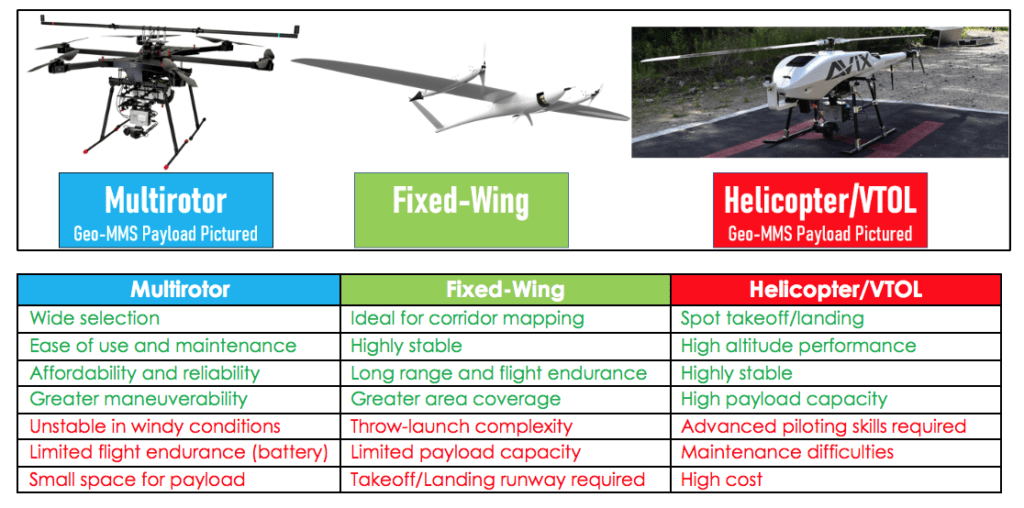Geo-MMS UAV Payload Capacity Selection Guide
The Geo-MMS suite of products can be mounted on a selection of Unmanned Aerial Vehicles (UAVs). For our concerns, UAVs with a payload capacity sufficient to support the Geo-MMS payload are categorized into three groups:
- Multirotor
- Fixed-Wing
- Helicopter/VTOL (Vertical Take Off & Landing)
The figure below summarizes the pros and cons of these three UAV categories from a performance, payload capacity and practicality standpoint (i.e. not related to safety, mechanical configurability etc.).
Multirotor
The most important factor to consider when selecting a multirotor UAV is the desired coverage area (or flight endurance capacity). The majority of battery-powered multirotor UAVs have a flight endurance capability less than 25 minutes with a typical Point&Pixel mapping payload. This flight endurance typically allows area coverage of ~100 acres @50m AGL. If the coverage area is significantly more, then a gas-powered or hybrid (gas-battery) multirotor UAV is recommended. In many cases, it may be feasible to use a battery-only UAV to cover an extensive area if the mission can be broken into stages, allowing time for battery replacement or recharging between stages. In any case, the main drawbacks of multirotor UAVs are their underlying sensitivities to vibrations and torques that are applied to the props during vertical ascent.
We receive a lot of questions and inquiries regarding battery power and flight endurance capabilities of different multirotor UAVs. It is important to note that all UAV manufacturers face the same limitations, and to a point, use essentially the same components. Yes, there are many different manufacturers of UAV equipment and parts, but differences tend to be incremental rather than fundamental. Any UAV manufacturer claiming exceptionally long flight times compared to others will have had to compromise their specification in one way or another to do so.
Fixed-Wing
The power limitations experienced by multirotor UAVs are addressed by fixed-wing platforms. The energy efficiency of these UAVs offers several advantages with respect to multirotor UAVs, particularly in terms of platform stability and greater area coverage capability. However, they do require a large and open space to perform a safe takeoff and landing. Fixed-wing UAVs are typically used in photogrammetry applications.
Helicopter/VTOL
The takeoff and landing requirements of fixed-wing UAVs are addressed by VTOL platforms. VTOL UAVs may be designed similarly to fixed-wing platforms or similarly to helicopters. While multirotor UAVs also take-off and land vertically, there is a distinction made between these categories. VTOL UAVs have multi-hour flight capability and can operate at both higher speeds and higher altitudes relative to other UAV categories, hence covering a larger area in a quicker time. The main drawback of this UAV category is the mechanical complexity and fragility they possess. These characteristics may lead to challenges during both transportation and operation.
Geodetics & LiDAR/Camera Options
As system integration specialists, Geodetics is tasked with continually integrating new sensors for our domestic and international clients and customers. Integrated sensors include LiDAR systems of differing effective ranges and cameras (RGB, multispectral, hyperspectral) to cover a wide array of applications.
However, unlike the sensor options, UAV options are limited to a number of key manufacturers with excellent reputations in the industry. Geodetics’ Geo-MMS payloads were initially integrated with multirotor systems and have since expanded to VTOL/Helicopter UAVs (e.g. thank you to RPM Aerial for their collaboration). Our products are UAV ‘agnostic’ and can be integrated as long as the platform has enough payload capacity to support the Geo-MMS payload. Meanwhile, the key to a successful Geo-MMS LiDAR or photogrammetry system is accurate alignment and calibration of sensors along the platform. Therefore, the design and assembly of the mounting bracket used to support the payload is critical.
Each UAV model is different, and each mounting bracket must be designed and tested for the specifications of the UAV. This task of mounting such a sophisticated payload to a new UAV is not one that should be taken lightly. Geodetics suggests against customers and clients attempting to carry out this work on their own without consultation or involvement of their engineering and scientific teams.
Each UAV has a unique vibration signature which demands accurate damper designs to denoise unexpected vibrations. Unaccounted-for vibrations cause many issues – from mechanical fatigue, which can wear out fragile parts and electrical components prematurely, to IMU sensor reading outputs, blurring the captured imagery and fanning effects displayed on LiDAR sensor measurements and subsequent point clouds. The figure below displays an example of the Geo-MMS Point&Pixel setup and how the sensors should be properly secured to the UAV platform.
When it comes to offering a new UAV platform for our Geo-MMS product suite, we must go through extensive inspection and flight testing to ensure the system geometry is stable enough to deliver the fine accuracies allowed by the LiDAR/camera sensors we integrate with.
There are a countless (and growing) number of UAV manufacturers, many of whom have arisen only in the past decade – the industry is ever evolving. Currently, Geodetics focusses on several key and reputable UAV manufacturers and models. The models we choose to integrate with cover the vast majority of applications we are involved in, including forestry, powerline, topography, surveying, BIM, etc. We collaborate with both US-made and international manufacturers of cost-effective multirotor and VTOL/Helicopter platforms. Should you own or plan on working with a UAV manufacturer that Geodetics does not currently work with, please request more information and our team will discuss the options available for your specific situation.

